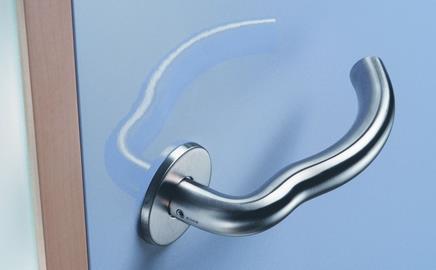Allgood Ironmongery made its name among the dreaming spires, but has also tackled the Gherkin and T5. Now it is trying out something new in the healthcare sector.
Allgood Ironmongery, one of the UK’s main makers of door and window ironmongery, was set up as a family company, G&S Allgood, in 1948. It made a name for itself in 1965 with the establishment of the Modric range of ironmongery, designed by Alan Tye, which came about as a result of its work with Arne Jacobsen for St Catherine’s College in Oxford.
Still a family company, it now supplies a total of seven ranges, mainly to new-build commercial schemes, that can be found in Foster + Partners’ Swiss Re building, Frank Gehry’s Maggie’s centre in Dundee, and Future Systems’ Selfridges in Birmingham. Allgood employs 110 people around the country, and had a turnover last year of about £18m. We speak to marketing manager Alan Field.
What’s the state of the market?
We are relatively busy. It was quite tough three years ago – the market and the competition was aggressive during that period – but we restructured, and we’ve now moved in a different direction.
Product- and service-wise, our focus has been a lot more targeted. We wanted to maintain the quality of our products while addressing the pricing of them in the market. We managed to provide savings to customers in the volume-based markets. With more PFI and PPP procurement, that’s meant we’ve started building better relationships with contractors as well as architects.
What are current trends in ironmongery?
With commercial projects, you tend to find that clients prefer to go with the tried and tested products, and so they tend to stick with our d-line range [designed by Dane Knud Holscher]. The Disability Discrimination Act obviously affected specification. The use of stainless steel and reflectivity issues did have an effect on us, but we’ve invested in the technology to monitor elements so that there’s the right amount of contrast to bring us in line with best practice for the DDA. Things like our door closers are more efficient and easier to operate.
Where do you source your materials?
All our products are generally manufactured in the UK, but on a project-by-project basis we may get materials from abroad.
What are your products’ lead times?
For most of our top-selling lines, such as d-line, it’s next-day delivery. If it’s not the most popular ranges, it may be a four-week lead time. It’s seldom that simple on most projects, though, as it can be two years between first contact with a client or contractor and the supply of the actual items.
Do you work with specifiers on bespoke solutions?
We are always open to bespoke solutions. We have been looking at new designs though, such as the White collection by Gavin Harris. Originally we were working with him on a particular project, and it ended up developing into an actual product range – stainless steel ironmongery with powder-coated elements – which is doing really well. As a business, you have to be open to meeting the client’s needs in a bespoke way.
Where are you supplying at the moment?
We are currently supplying items to Richard Rogers’ Heathrow Terminal 5 building, the O2 Arena in the Millennium Dome and University College Hospital in London. The PFI market was quite a hard nut to crack, but we seem to be supplying more and more to that sector. The whole industry seems to be becoming more contractor- rather than architect-led, and they seem more powerful in the decision-making and specification process.
Are you working on any new ideas or innovations?
In this business, you always have to look at product development, but it’s also about innovating in offering client-tailored services and solutions as well. Recently we’ve been targeting the healthcare market and came up with BioCote – an anti-microbial silver ion coating available as a finish to our medical ironmongery. It’s an example of a specific product innovation for a particular sector.
Topics
Specifier 5 April 2007

Doors and windows
- 1
- 2
 Currently
reading
Currently
reading
Allgood Ironmongery: Iron in the soul
- 4
- 5
- 6
- 7
- 8
- 9
- 10
- 11
- 12
- 13
- 14
- 15











































No comments yet